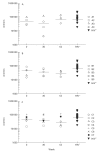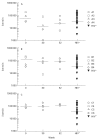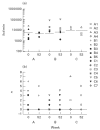Effects of IL-2 therapy in asymptomatic HIV-infected individuals on proliferative responses to mitogens, recall antigens and HIV-related antigens
- PMID: 9697988
- PMCID: PMC1905022
- DOI: 10.1046/j.1365-2249.1998.00633.x
Effects of IL-2 therapy in asymptomatic HIV-infected individuals on proliferative responses to mitogens, recall antigens and HIV-related antigens
Abstract
The effects of IL-2 therapy on lymphoproliferative responses to mitogens, recall antigens and HIV epitopes were studied in asymptomatic HIV-infected patients enrolled in a phase II study of intermittent continuous intravenous (Ci.v.) IL-2 and subcutaneous infusions of polyethylene glycol-modified (PEG) IL-2. Sixteen consecutive patients randomized to receive Ci.v. IL-2 (n = 5), PEG IL-2 (n = 7) or anti-viral therapy alone (n = 4) were studied. All patients were vaccinated with tetanus toxoid (TT) before receiving therapy. Proliferative responses to phytohaemagglutinin (PHA), soluble anti-CD3, TT, streptokinase/streptodornase (SK/SD) and 11 previously described HIV-specific T-helper epitopes from gag and env were studied at weeks 0, 16, 30 and 48. Median CD4+ lymphocyte increases of 272 and 255CD4+ cells/microl were observed in the Ci.v. IL-2 and PEG IL-2 groups at week 48, while decreasing by 104 cells/microl in the anti-retroviral therapy alone group. At each time point proliferative responses to PHA, anti-CD3, TT and SK/SD were not different between treatment arms. Similarly, no differences in responses to HIV epitopes were found between the groups and no new responses to HIV epitopes were detected. IL-2 therapy results in a significant increase in peripheral blood CD4+ lymphocyte count, but this increase is not associated with quantifiable improvements in lymphoproliferative responses to mitogens, recall or HIV antigens.
Figures



Similar articles
-
Immune reconstitution in HIV-1 infected subjects treated with potent antiretroviral therapy.Sex Transm Infect. 1999 Aug;75(4):218-24. doi: 10.1136/sti.75.4.218. Sex Transm Infect. 1999. PMID: 10615305 Free PMC article. Review.
-
HIV-specific lymphoproliferative responses in asymptomatic HIV-infected individuals.Clin Exp Immunol. 1995 Jun;100(3):419-24. doi: 10.1111/j.1365-2249.1995.tb03716.x. Clin Exp Immunol. 1995. PMID: 7774051 Free PMC article.
-
Comparison of subcutaneous and intravenous interleukin-2 in asymptomatic HIV-1 infection: a randomised controlled trial. ANRS 048 study group.Lancet. 1999 Jun 5;353(9168):1923-9. doi: 10.1016/s0140-6736(98)07345-0. Lancet. 1999. PMID: 10371571 Clinical Trial.
-
Prospective analyses of HIV-1-specific proliferative responses, recall antigen proliferative responses, and clinical outcomes in an HIV-1-seropositive cohort.J Infect Dis. 2004 Jun 1;189(11):1988-95. doi: 10.1086/386285. Epub 2004 Apr 30. J Infect Dis. 2004. PMID: 15143464
-
Low-dose daily subcutaneous interleukin-2 in combination with highly active antiretroviral therapy in HIV+ patients: a randomized controlled trial.HIV Clin Trials. 2000 Nov-Dec;1(3):1-15. doi: 10.1310/T5FR-8JPX-0NEF-XDKD. HIV Clin Trials. 2000. PMID: 11590500 Clinical Trial.
Cited by
-
Immunological changes in peripheral blood and in lymphoid tissue after treatment of HIV-infected subjects with highly active anti-retroviral therapy (HAART) or HAART + IL-2.Clin Exp Immunol. 1999 Jun;116(3):486-92. doi: 10.1046/j.1365-2249.1999.00927.x. Clin Exp Immunol. 1999. PMID: 10361239 Free PMC article. Clinical Trial.
-
Interleukin-2 as an adjunct to antiretroviral therapy for HIV-positive adults.Cochrane Database Syst Rev. 2017 May 25;5(5):CD009818. doi: 10.1002/14651858.CD009818.pub2. Cochrane Database Syst Rev. 2017. PMID: 28542796 Free PMC article.
-
Discordant effects of interleukin-2 on viral and immune parameters in human immunodeficiency virus-1-infected monocyte-derived mature dendritic cells.Clin Exp Immunol. 2003 May;132(2):289-96. doi: 10.1046/j.1365-2249.2003.02143.x. Clin Exp Immunol. 2003. PMID: 12699419 Free PMC article.
-
Immune reconstitution in HIV-1 infected subjects treated with potent antiretroviral therapy.Sex Transm Infect. 1999 Aug;75(4):218-24. doi: 10.1136/sti.75.4.218. Sex Transm Infect. 1999. PMID: 10615305 Free PMC article. Review.
-
Immunological effects of interleukin-2 therapy in human immunodeficiency virus-positive subjects.Clin Diagn Lab Immunol. 2001 Jul;8(4):671-7. doi: 10.1128/CDLI.8.4.671-677.2001. Clin Diagn Lab Immunol. 2001. PMID: 11427409 Free PMC article. Review. No abstract available.
References
-
- Schrier R, Gnann JJ, Landes R, et al. T cell recognition of HIV synthetic peptides in a natural infection. J Immunol. 1989;142:1166–76. - PubMed
-
- Wahren B, Rosen J, Sandstrom E, Mathiesen T, Modrow S, Wigzell H. HIV-1 peptides induce a proliferative response in lymphocytes from infected persons. J Acq Imm Def Syndr. 1989;4:448–56. - PubMed
Publication types
MeSH terms
Substances
LinkOut - more resources
Full Text Sources
Medical
Research Materials

